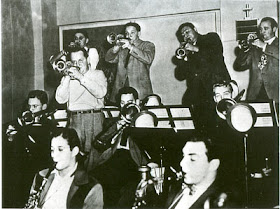Randolph E. “Randy” Brooks (15 Mar 1919 - 21 Mar 1967) was an excellent American swing based trumpeter and band leader, known as "The Golden Trumpet." In 1947, Brooks' version of "Tenderly," became the most requested song in the country.
 Brooks got his start at the age of 8, playing in a cornet
trio with his parents in the Sanford Salvation Army band. When he was 12,
Brooks won a competition for young trumpet players, beating out over 2,000
other entrants. Two years later, at the age of 14, he gained national fame with
his appearances on Rudy Vallee's national radio program, where he was asked to
be a permanent member of the band. However, he was too young to sit in with the
regular brass section, so each week he would perform a classical trumpet solo
to rave reviews.
Brooks got his start at the age of 8, playing in a cornet
trio with his parents in the Sanford Salvation Army band. When he was 12,
Brooks won a competition for young trumpet players, beating out over 2,000
other entrants. Two years later, at the age of 14, he gained national fame with
his appearances on Rudy Vallee's national radio program, where he was asked to
be a permanent member of the band. However, he was too young to sit in with the
regular brass section, so each week he would perform a classical trumpet solo
to rave reviews.
After graduating from Sanford High in 1937, Brooks went to
New York City to seek his fortune in the music business. After a few years of
playing in other bandleader's orchestras such as Hal Kemp and les Brown, Brooks
started his own band in 1944. In 1946, his band began a successful run at New
York's famed Roseland Ballroom.
Brooks' band set the record for the longest run at the
Roseland, and was named "best new orchestra" for 1946. Besides the
gig at the Roseland, the Randy Brooks Band was selected to play the annual
"Harvest Moon Festival" at New York's Madison Square Garden. The
young Stan Getz was in the band for a short period in 1946.
In 1947, Brooks' band
had been named "one of the best bands in the nation" by Downbeat
Magazine, a music business publication. Brooks' Decca recordings were gaining
nationwide fame. Besides "Tenderly," which sold over a million
copies, Brooks also recorded
 songs such as: "Don't Let Me Dream,"
"Moonmist," "Harlem Noctrum," and "Laughing on the
Outside (Crying on the Inside)".
songs such as: "Don't Let Me Dream,"
"Moonmist," "Harlem Noctrum," and "Laughing on the
Outside (Crying on the Inside)".
 songs such as: "Don't Let Me Dream,"
"Moonmist," "Harlem Noctrum," and "Laughing on the
Outside (Crying on the Inside)".
songs such as: "Don't Let Me Dream,"
"Moonmist," "Harlem Noctrum," and "Laughing on the
Outside (Crying on the Inside)".
Brooks married fellow bandleader Ina Ray Hutton and moved to
Los Angeles where tragedy struck.In 1950, as he was at the height of his
popularity, Brooks suffered a cerebral stroke which left him partially
paralyzed and unable to perform. He briefly returned following rehabilitation,
but suffered a second stroke in 1958, and retired in 1961.
He died March 21, 1967 in a fire at his Springvale apartment
at the age of 48. Today he is largely forgotten and unfortunately his generally
rewarding recordings are mostly out of-print. Randy Brooks deserved much
better.
(Edited from AllMusic and mainly from a bio by Paul Auger @ findagrave)




For “Randy Brooks & His Orchestra - Lang-Worth Recordings 1945-1947” go here:
ReplyDeletehttps://www.upload.ee/files/9758352/Randy_Brooks_45-47.rar.html
1. Holiday Forever 1:01
2. Stompin' at the Savoy 4:06
3. There's That Lonely Feeling Again (feat. Harry Prime) 3:564
4. People Who Live in Glass Houses (feat. Kay Allen) 2:30
5. Carry Me Back to Old Virginny 3:05
6. Like a Leaf in a Wind (feat. Harry Prime) 3:42
7. Come to Baby Do (feat. Lillian Lane) 4:08
8. I Wonder Who's Kissing Her Now 1:51
9. I'll Be Walking with My Honey (feat. Margie Woods) 2:20
10. Mississippi Cantabile 2:16
11. That's for Me (feat. Bill Usher) 3:24
12. I Ain't Gonna Give Nobody None O' This Jelly Roll (feat. Aileen Stanley, Jr.) 2:06
13. Moonglow 3:07
14. Tumbling Tumbleweeds (feat. Harry Prime) 3:35
15. Can't You Read Between the Lines? (feat. Margie Woods) 2:48
16. Brooks Boogie 2:53
17. More Than You Know 3:24
18. Walking Away with My Heart (feat. Kay Allen) 3:16
19. To Beat or Not to Beat 3:38
20. Lullaby of the Leaves 3:28
21. June Comes Around Every Year (feat. Bill Usher) 3:41
22. A Night at the Deuces 2:54
23. Tenderly (Bonus Track)
Released: 1 Jan 1992
℗ 1992 Circle Records
Circle Records issued a series of Lang – Worth recordings by different artists (Vol 2 being Randy Brooks and His Orchestra)
Lang-Worth was a company that provided music to radio stations on a subscription basis and never released their music for purchase by the public. This service filled the gap during the musicians strike against the major record companies between 1942 - 1944. Lang-Worth continued to do business for a number of years after WWII and expanded their product offerings to retailers, department stores, garages and so on for use in local radio jingles and cinema adverts. Many post-war records were pressed on a distinctive semi-clear blue vinyl. Little other information is known about the label.
I added “Tenderly” (track 23) as a bonus as it was his million seller.
Thanks! (I hadn't heard of Randy Brooks before,
ReplyDeletebut I'm looking forward to . . . giving a listen.)
Bob,
ReplyDeleteThank you for all the music. Please reup this collection, thank you :-)
Hello HP, Here's Randy.......
ReplyDeletehttps://www.imagenetz.de/jeYJ2